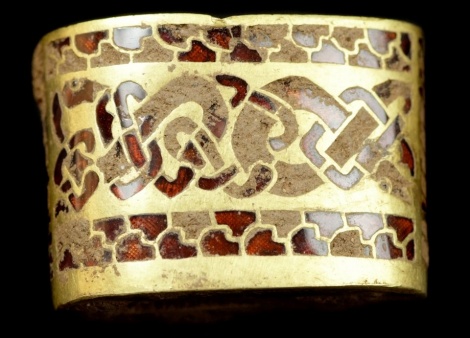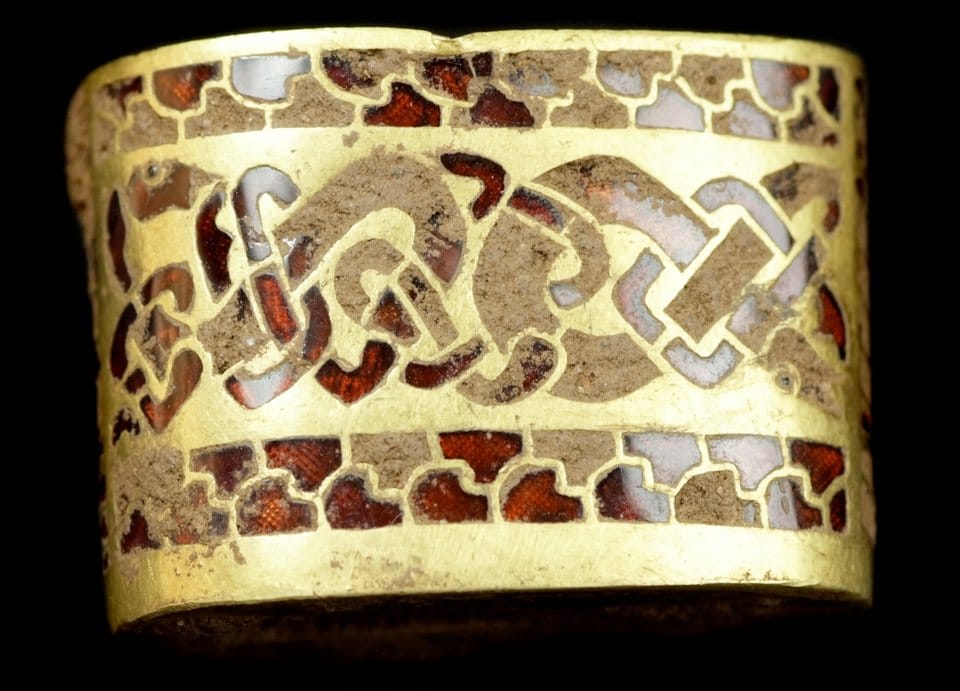Amazing what historians can’t figure out. The guys who wrote the Keys to Avalon would like to attribute the construction of Offa’s Wall to Romans despite all evidence to the contrary. Offa was the king of Mercia which has since become Middle England. He built a wall between Wales and his realm.
A more recent discovery from the Mercian period is the magnificent Staffordshire Hoard. Historians can’t figure out why such a rich deposit was buried in the ground and forgotten. In the deposit, there are largely purely martial items. Sword pommels, sword hilt fittings, shield fittings.
The blades and shields themselves are not among the treasure.

staffordshire hoard treasure
It’s pretty clear what happened here. It was a band of soldier assassins, probably sent from a rival duke who wailaid the bodyguard of another thane. Their mission was covert – they could not be seen with items which identified them as the murders. So they immediately removed the fittings, stuck them in some kind of bag of cloth or leather and buried them in the ground. They marked the spot to come back to recuperate the items much later, when their identification as the murderers would cause no grief.
In the meantime, they took the excellent but now unadorned and anonymous swords and daggers and shields which belonged to their very wealthy victims to arm themselves.

staffordshire hoard mercian treasure of treachery
After their departure, the band of assassins was either murdered by their patron or themselves died in battle. It could very well be on their way home through enemy territory, they were challenged and perished to a man, the location of their treasure with them.
In support of version one, many historical examples exist of henchman murdered by their master, from Chrysogonus by Sulla, the endless Tudor murders, to Yagoda and Yezhok by Stalin. The master would have no interest in recovering the treasure as it would immediately identify him with the blood treacherously spilled.
Often when hiding treasure, the leaders of such a group would go off separately with the treasure to hide or bury it. So it could be as little as one or two men who would have known the final resting place of that treasure. Upon their death, deliberate or accidental, the treasure remained buried until 2009.
So the Staffordshire Hoard is almost certainly the treasure of treachery.


A rather unlikely scenario given that there are about 80 gold sword pommels in the hoard. They were rare luxury items owned exclusively by the social elite and swords themselves were carried by few warriors on the battlefield. The spear was the most common Saxon weapon. For one encounter to yield so many pommels suggests a major battle or series of battles. The way in which the fittings have been prized and hacked off and smashed with no regard to their immense value suggests a votive offering – the god’s portion – offerd in thanks for a successful campaign.
Hi Patrick,
Thanks for stopping by.
Was there a Saxon tradition of mutilating weapons to make votive offerings?
Given the trouble involved in making such pommels I have trouble believing that a group of warriors would do this.
Moreover if it was an offering to the gods, I expect there would have been the usual foodstuffs and animal carcasses next to the gold. I didn’t read that there were any indications of an offering.
I still think it’s more likely that people wanted to keep the weapons but couldn’t do so with the pommels intact.
The mystery lingers.